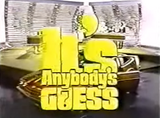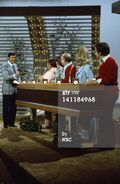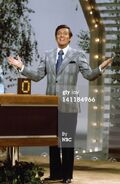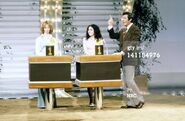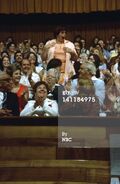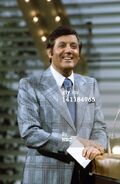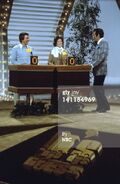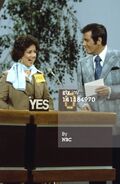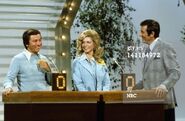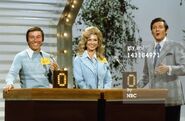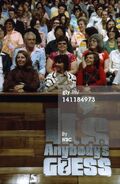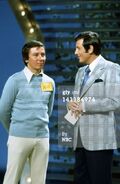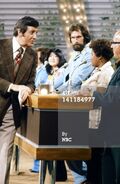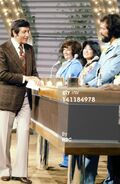| Host | |
| Monty Hall | |
| Announcer | |
| Jay Stewart | |
| Broadcast | |
| Pilots: 2/4/1977 NBC Daytime: 6/13/1977 – 9/30/1977 | |
| Packager | |
| Stefan Hatos-Monty Hall Productions | |
"Somebody in our studio audience could have a chance today to win $5,000, plus this 1977 car, as we play... It's Anybody's Guess! And now, meet our audience player(s) who is/are returning for his/her/their second game; here's (insert contestant)! (And now, (a) new player(s) from our studio audience, (insert new studio audience contestant(s))!) And now, here's the star of our show, Monty Hall!"
It's Anybody's Guess was Monty Hall's first post-Let's Make a Deal show, played very similar to Match Game but with an answer given already and it was up to the contestants to predict whether or not the panel guessed it.
Gameplay[]
The show featured seven people involved in each episode. Two of the people were players, with one usually a returning champion, and five of the others made up a panel. The second contestant was always a member of the previous show's panel, having qualified to challenge the champion based on their winnings on the previous show. As such, the panel changed on an almost-daily basis. A panelist was limited to two consecutive appearances in the panel without becoming a challenger, and a replacement from a panelist-turned-challenger was chosen from the audience.
Main game[]
A question with many possible answers would be posed to everyone (for example: "What makes a camel funny looking?") and an answer that was selected by the show's staff was shown to the challenging player in control of the question and the home audience (with the previous example, "his knobby knees" would be the answer shown). The player decided if the answer would be said by any of the five panelists (yes or no). The player then decided to "play it safe" or go for the "longshot".
Hall then asked the panelists for an answer. If the player played it safe, then he asked each of the panelists for one answer. Should the player call for a longshot, if he or she said yes (that the panelists would get the answer), he only asked three panelists for an answer (or, if the contestant said no, that the panelists wouldn't get the answer, all five panelists were asked for an answer, and the first two were asked for a second answer, for a total of seven answers).
If one of the five panelists guessed the selected answer, he or she received a prize. If the contestant predicted correctly, he or she scored one point (two points for a longshot); an incorrect prediction awarded the point(s) to the opposing player. The first player to score five points won the game.
Payoff Round[]
One more question was asked to the winner and the panelists. There were two answers (that were not shown to anyone at first) that were chosen by the staff. Hall would ask each panelist for a response to the question in reverse order. Each incorrect response was worth $300. After five responses, if either of the two chosen answers were not given, the player received a chance for the top prize, but the player had to eliminate one of the two chosen answers from play.
At this point, the player could quit after each incorrect response with the accumulated cash. If the panelists still did not say the selected answer still in play, the player won $5,000 and a new car. If one of the two answers were said prior to the halfway mark of the round, but the second response wasn't said after all ten responses, the player just won $5,000. If the panelists said both answers, the player lost any cash accumulated in the Payoff Round. Note that a panelist could win more prizes if he or she gave one of the chosen responses.
The panelist who won the most prizes in the game became the new challenger in the next game. Winning contestants were able to compete up to a maximum of five games or until defeated.
Gallery[]
Press Photos[]
Music[]
Sheldon Allman & Stan Worth
The prize cues were also used on both the 1976 and 1980 versions of Let's Make a Deal.
The main theme of this show was also recycled as a prize cue in The All New Let's Make a Deal.
Inventors[]
Stefan Hatos & Monty Hall
Studio[]
NBC Studio 3, Burbank, California

